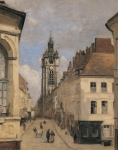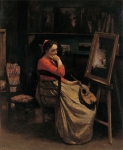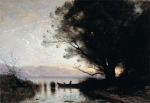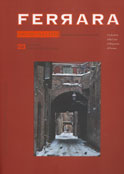Di formazione neoclassica, Corot fece tesoro dell'insegnamento dei suoi maestri: il pittore accademico Achille-Etna Michallon, nel cui studio entrò nel 1822, e Jean-Victor Bertin che lo accolse alla morte del primo. Presso gli atelier di questi celebri paesaggisti neoclassici, Corot studiò gli antichi maestri, apprese l'ordine compositivo dell'arte classica, ma imparò anche ad accostarsi alla natura in maniera diretta, esercitandosi nella pittura dal vero con una sincerità e una tenacia che non lo abbandonarono mai nel corso della sua lunga carriera.
La capacità di entrare in sintonia con la natura, il talento nel restituirne la vibrazione sulla tela, unite a una maestria nel dipingere e nell'organizzare la composizione che non di rado tocca la perfezione formale, sono le qualità distintive dell'opera di Corot, e la ragione per cui, oggi come allora, è considerato a un tempo l'erede del paesaggio classico e uno dei padri della pittura moderna.
 Per rendere omaggio all'eccezionale statura di questo maestro francese, Ferrara Arte presenta quest'autunno, al Palazzo dei Diamanti, un'ampia retrospettiva, organizzata in collaborazione con il Museo Thyssen-Bornemisza di Madrid. La rassegna rinnova la prestigiosa tradizione espositiva della città, che nasce dalla felice collaborazione fra Comune e Provincia di Ferrara, Fondazione Cassa di Risparmio di Ferrara e Cassa di Risparmio di Ferrara.
Per rendere omaggio all'eccezionale statura di questo maestro francese, Ferrara Arte presenta quest'autunno, al Palazzo dei Diamanti, un'ampia retrospettiva, organizzata in collaborazione con il Museo Thyssen-Bornemisza di Madrid. La rassegna rinnova la prestigiosa tradizione espositiva della città, che nasce dalla felice collaborazione fra Comune e Provincia di Ferrara, Fondazione Cassa di Risparmio di Ferrara e Cassa di Risparmio di Ferrara.Il percorso della mostra ha un ordinamento tematico che conduce il visitatore alla scoperta dell'opera di Corot, mettendo in luce l'ampiezza e la varietà dei motivi sperimentati dal pittore, per ciascuno dei quali egli formulò soluzioni di grande qualità e originalità.
Gli autorevoli critici e letterati contemporanei che sostennero e celebrarono l'opera di Corot - da Baudelaire, a Gautier, a Zola - conobbero soprattutto le tele di grande formato che il pittore presentava ogni anno al Salon, l'esposizione patrocinata dal governo che costituiva il cuore della vita culturale francese.
Essi avevano una conoscenza parziale di quel vasto repertorio di bozzetti en plein air conservato nello studiodel pittore e noto a una ristretta cerchia di artisti, critici e collezionisti, che era la fonte d'ispirazione della sua pittura ufficiale.
 Furono soprattutto la vendita dell'atelier, avvenuta nel 1875, alla scomparsa dell'artista, e una mostra imponente allestita lo stesso anno che rivelarono alla gran parte dei contemporanei la modernità e la libertà d'esecuzione delle sue prove dal vero, a partire dai "bozzetti italiani", presto riconosciuti un immediato precedente della pittura impressionista.
Furono soprattutto la vendita dell'atelier, avvenuta nel 1875, alla scomparsa dell'artista, e una mostra imponente allestita lo stesso anno che rivelarono alla gran parte dei contemporanei la modernità e la libertà d'esecuzione delle sue prove dal vero, a partire dai "bozzetti italiani", presto riconosciuti un immediato precedente della pittura impressionista.Corot aveva aderito con entusiasmo alla consuetudine di completare l'apprendistato artistico con un viaggio in Italia, trattenendosi nel nostro Paese dal 1825 al 1828, e facendovi ritorno ancora nel 1834 e nel 1843.
Qui, nel corso delle lunghe sessioni di pittura all'aperto in compagnia di artisti di diverse nazionalità, il giovane pittore si era accostato alla natura con un atteggiamento sperimentale, raffigurandola con una freschezza e una verità sorprendenti.
Ne sono una testimonianza tangibile i "paesaggi puri" presentati nella sezione dedicata ai soggiorni italiani: basti pensare alla libertà con cui Corot con poche energiche pennellate rende l'aspetto aspro dei dintorni di Olevano o traduce la potente vitalità della cascata delle Marmore in un mosaico di tocchi di colori brillanti accostati sulla tela.
Nei dipinti di Corot, tuttavia, nonostante l'apparente spontaneità d'esecuzione, nulla è lasciato al caso.
L'artista ha costantemente presenti i principi della composizione classica che gli consentono di dare ordine e stabilità al caos di una natura selvaggia.
Ne è un bellissimo esempio Civita Castellana, un bozzetto in cui Corot trascrive con un tratto vigoroso, a forti contrasti chiaroscurali, l'impervia parete rocciosa e la rigogliosa vegetazione verde cupo, inquadrandole però in una composizione meditata ed equilibrata.
L'attenzione del pittore si appuntò anche sul panorama della Città eterna e sui più noti soggetti del repertorio di vedute romane, come mostrano Castel Sant'Angelo e il ponte con la cupola di San Pietro o il pendant che raffigura il Foro e il Colosseo.
In queste celebratissime vedute, Corot combina con insuperabile maestria i monumenti più sacri ed emblematici della città in una limpida sequenza di volumi modellati dall'intensa luce mediterranea.
La compiuta bellezza di queste opere dimostra come la pittura dal vero non fosse per Corot un esercizio di trascrizione passiva, ma un'attività di invenzione formale, attraverso la quale l'artista interpretava i soggetti tradizionali come una successione di masse e di piani scanditi dal contrasto di luci e di ombre.
Al rientro in patria, Corot volse la sua attenzione al paesaggio delle province francesi, che avrebbe studiato e ritratto per tutta la vita nel corso di viaggi ed escursioni.
Il percorso della mostra ricostruisce un itinerario ideale attraverso le mete predilette delle sue peregrinazioni: per ciascuna di esse l'artista ha saputo comporre un ritratto indimenticabile, spinto dal desiderio di penetrare profondamente l'universo delle forme naturali per restituirne ogni sfumatura, arrivando a catturare sulla tela il carattere peculiare e inconfondibile di ogni regione.
 I dipinti eseguiti a Fontainebleau sono un documento di grande verità, che rispecchia il fascino singolare di quell'antica foresta dall'aspetto selvaggio e incontaminato, dove l'anziano maestro avrebbe condotto i giovani impressionisti a dipingere en plein air e dove, già dalla fine degli anni Venti, egli aveva sperimentato un approccio diretto e fedele alla natura, accanto ai pittori della scuola di Barbizon.
I dipinti eseguiti a Fontainebleau sono un documento di grande verità, che rispecchia il fascino singolare di quell'antica foresta dall'aspetto selvaggio e incontaminato, dove l'anziano maestro avrebbe condotto i giovani impressionisti a dipingere en plein air e dove, già dalla fine degli anni Venti, egli aveva sperimentato un approccio diretto e fedele alla natura, accanto ai pittori della scuola di Barbizon. Un'atmosfera completamente diversa, serena e sottilmente lirica, contraddistingue invece i paesaggi dipinti nei dintorni della tenuta di famiglia a Ville d'Avray: qui, l'artista si sofferma a descrivere con impareggiabile freschezza il riverbero del sottobosco, i riflessi sugli stagni e l'esistenza tranquilla degli abitanti.
La piena maturazione del raffinato naturalismo corotiano si apprezza infine nella celebre icona della tarda attività, Il campanile di Douai. Il tracciato fluido e conciso del pennello sembra trascrivere, quasi "in presa diretta", la vita quotidiana della cittadina del nord, mentre la resa magistrale della luce vibrante e degli effetti atmosferici contribuiscono a dare «l'impressione del movimento delle cose», per usare le parole dell'artista.
Dotato di un'indole gioviale e generosa, Corot nutrì un interesse profondo per la rappresentazione della figura, che in parte derivava dalla sua formazione neoclassica. Spesso presente nei suoi paesaggi, la figura venne trattata anche come un genere autonomo, con esiti di grande originalità e intensità.
Di questo talento, a lungo oscurato dalla fama di paesaggista, si resero conto innanzitutto artisti come Van Gogh, Degas e Picasso che ammirarono, collezionarono e copiarono i suoi studi di modelli. Nel corso del Novecento, monografie e mostre consacrarono definitivamente la notorietà dei suoi ritratti, dei suoi nudi e delle sue figure in costume, mettendo in luce la qualità di questa produzione, cui è dedicata un'ampia sezione della rassegna.
 Capolavori della ritrattistica corotiana come Madame Corot, madre dell'artista, rivelano le sue eccezionali doti di penetrazione psicologica e di resa realistica del soggetto. Il dipinto, eseguito intorno al 1835, restituisce con sorprendente immediatezza l'espressione stupita e un po' apprensiva della madre e il suo abbigliamento curato, da modista elegante.
Capolavori della ritrattistica corotiana come Madame Corot, madre dell'artista, rivelano le sue eccezionali doti di penetrazione psicologica e di resa realistica del soggetto. Il dipinto, eseguito intorno al 1835, restituisce con sorprendente immediatezza l'espressione stupita e un po' apprensiva della madre e il suo abbigliamento curato, da modista elegante.Altrettanto notevoli sono i nudi femminili, bellissime figure di matrice classicista, ritratte con assoluta naturalezza e una sottile carica sensuale, immerse nell'atmosfera umida e vibrante di un rigoglioso paesaggio.
Ma la portata innovativa della pittura di Corot si coglie pienamente negli studi di modelli, in quelle sublimi invenzioni della tarda maturità che il curatore della mostra ha definito "figure di fantasia".
Ne sono squisiti esempi L'atelier di Corot o Christine Nilson. La gitana con mandolino, in cui il pittore ritrae figure femminili in costume colte in atteggiamenti assorti e incantati. Il gioco di accordi cromatici, l'intonazione calda della luce e le stesure vibranti accrescono la forza evocativa di questi dipinti che sembrano tradurre in forma pittorica lo stato d'animo del soggetto e l'intensità del suo fantasticare.
Una delle intenzioni di questa mostra è porre l'accento su un ulteriore, affascinante aspetto della ricerca di Corot, delineato già nel sottotitolo, "natura, emozione, ricordo".
La genialità di questo artista non si esaurì, infatti, nella verità dei suoi bozzetti en plein air o nella bellezza dei quadri di figura; egli seppe tradurre in raffinati paesaggi di fantasia le emozioni e i ricordi che lo spettacolo naturale aveva suscitato nel suo animo.
Fin dagli anni trenta Corot, fedele alla sua formazione di paesaggista neoclassico, aveva presentato al Salon "paesaggi eroici" nei quali ricomponeva brani studiati en plein air in uno scenario naturale immaginario che faceva da sfondo a episodi tratti dalla storia, dalla letteratura o dal mito.
 Nel corso degli anni, egli impresse un progressivo, radicale rinnovamento in senso romantico a quel genere della tradizione: la sua opera acquisì accenti lirici e personali, mentre i contenuti narrativi divennero sempre meno preponderanti, lasciando spazio all'espressione dei sentimenti.
Nel corso degli anni, egli impresse un progressivo, radicale rinnovamento in senso romantico a quel genere della tradizione: la sua opera acquisì accenti lirici e personali, mentre i contenuti narrativi divennero sempre meno preponderanti, lasciando spazio all'espressione dei sentimenti. Nel Mattino. La danza delle ninfe presentato al Salon del 1850-51, il tema del baccanale è soltanto un pretesto per celebrare un sentimento di profonda comunione con la natura. Le spensierate figure danzanti si fondono nell'atmosfera soffusa e incantata dello scenario boscoso, dal quale sembrano essere appena emerse.
Ma è nei quadri di ricordo che, come ha dimostrato Vincent Pomarède, curatore della rassegna, si può riconoscere il punto d'arrivo delle ricerche di Corot.
In questi paesaggi di memoria l'artista s'ispira a una località studiata dal vero, ma non descrive fedelmente l'aspetto del luogo: egli cerca piuttosto di rievocare e di trascrivere sulla tela le impressioni visive e le emozioni provate di fronte alla natura.
Ricordo di Riva, del 1865-70, appare, infatti, la trasfigurazione in forma di sogno della località visitata e ritratta più di trenta anni prima: le sponde rocciose del lago si sono praticamente dissolte nell'atmosfera brumosa, mentre i pochi dettagli descritti, come la vegetazione lacustre e la barca col pescatore, si specchiano e si confondono nei riflessi dell'acqua.
La visione personale e soggettiva del pittore s'intreccia in queste opere all'ispirazione musicale, che diviene un elemento fondamentale del suo processo creativo.
Corot era, infatti, un appassionato di musica e un assiduo frequentatore dell'Opéra, e acquisì un autentico senso del ritmo e della melodia, che si riflette nella struttura compositiva di alcune sue opere.
Ne è un sublime esempio Ricordo di Mortefontaine, dove alla posa coreografica della figura protesa a raccogliere il vischio fa eco il movimento delle fronde degli alberi che si flettono nella stessa direzione, accompagnato da un sottile gioco di luci mattutine che fa vibrare la superficie pittorica.
La rievocazione fantastica e l'invenzione formale prendono il sopravvento sulla descrizione del parco all'inglese, dimostrando l'originalità di una ricerca artistica che traduce in una perfetta armonia di forme e colori gli stati d'animo che la natura suscita in chi l'osserva con totale devozione.




